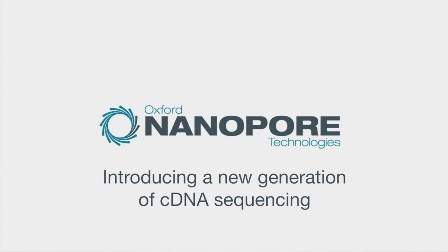
The new kits provide high throughput whilst generating complete sequences of full-length cDNA strands, with a low input option of just 1ng PolyA+ RNA.
The new cDNA sequencing method enables users to sequence whole transcriptomes to high coverage on a single MinION flow cell (10-15 million reads x full length transcripts), with substantially higher throughput capabilities on PromethION (more than 60 million reads x full length transcripts per flow cell), or smaller, rapid assays on Flongle. This facilitates new biological insights across a diverse range of applications.
Full-length, well-characterised cDNA transcripts for scientific research, health and industry
Oxford Nanopore’s new long-read cDNA sequencing solutions allow researchers to sequence millions of whole transcripts end-to-end in single reads. This enables users to simultaneously perform accurate isoform-level transcriptome characterisation, and differential gene expression profiling without any of the compromises on cost, quantitation, computational or workflow complexity required to achieve this on other short or long read sequencing platforms.
Deeper insight into the dynamics of the transcriptome are critical in enabling researchers across a broad range of fields to understand how the stable DNA ‘code’ of an organism is interpreted at a given moment in time. In healthcare, the identification of differentially spliced isoforms and fusion transcripts can inform disease diagnosis and treatment. RNA sequencing also provides a rapid, effective method of virus identification, and also has applications in environmental and agricultural science.
Jonathan Gӧke from the Genome Institute of Singapore said: “We are working on identification of alternative gene isoforms and fusion genes in cancer, and the ability to generate reads that span the entire RNA can make a big difference. With nanopore long read cDNA sequencing kits we obtain a much more detailed view of which transcripts are generated.”
Anthony Bayega from McGill University said: “Nanopore cDNA Sequencing Kits have provided us with quick workflows, full-length quantitative transcripts, and eased our data analysis since complex statistical considerations that need to be taken for short-read data, where full-length resolution of genes is difficult to determine, are not necessary.”
in relation to his use of the PCR-cDNA Kit to study the transcriptome of the developing olive fly embryo.
Direct cDNA and PCR-cDNA options
The two new kits now available are Direct cDNA (SQK-DCS109) and PCR-cDNA (SQK-PCS109) Sequencing Kits. In combination with upgrades to the Oxford Nanopore sequencing platforms and software, nanopore cDNA sequencing delivers effective enrichment for full-length transcripts (PCR-cDNA). In the case of the Direct cDNA kit, PCR is not necessary — removing bias, whilst the cDNA- PCR kit enables high throughput from low RNA input (just 1 ng PolyA+ RNA) and provides the option of starting from total RNA. The kits, which require less than 5 hours sample preparation time end-to-end, with little of this representing hands-on time, are now available to buy in Oxford Nanopore’s store.
The new cDNA kits are available to use on all Oxford Nanopore devices, from the pocket-sized MinION to the benchtop GridION and the high-throughput PromethION. This allows users of any scale to generate very high yields of transcriptomic data for high-resolution novel isoform discovery, identification of low copy number transcripts and de novo sequencing of entire transcriptomes to high coverage. Small, rapid devices such as Flongle are also ideal for targeted cDNA sequencing of specific transcripts.
In addition to cDNA sequencing, Oxford Nanopore also uniquely offers direct RNA analysis kits, allowing users to sequence RNA without the need to convert to cDNA.
Source: Company Press Release






